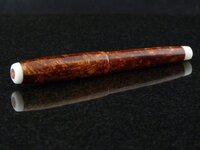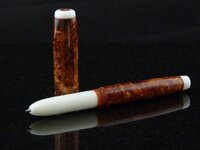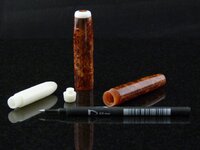Hendu3270
Member
I need to stop with these long winded threads. I finish typing and look back and say, geez! I'm gonna lose everyone's attention in the first paragraph! Oh well, I'm not editing it down….
I recently started a thread about metal lathes vs. wood lathes when it comes to kitless pens, and I've decided to not get a metal lathe for the time being. Although I may end up getting a better quality wood lathe instead. Not sure just yet.
This is my first attempt at a kitless pen. Obviously it's a rollerball and not a fountain, so please don't "shun" me for that. It's turned from a Molten Bronze Rhino blank (had it on hand and seemed like it was worth a shot) and white corian. It uses an ink cartridge from a Magnetic Vertex kit that I had used for parts awhile back. I used 12x0.75 and 9x0.75 for threading. I also used I believe a ¼" tap and die, that I already had, for the little end cap. The end cap is totally useless, but it comes off, so that's something I guess.
I broke the thread area of the first section I made twice, and was really discouraged at that point, thinking I may not be able to deal with these thin materials at my skill level and/or on a wood lathe. It turned out that I was drilling the interior hole for the ink cartridge larger than I needed, and was leaving the threaded area too thin. On the third one, I decreased the interior hole size to fit the cartridge better and it left me with more material to work with at the threads. Once I got that issue figured out, things moved along at a much better pace.
Obviously since this was my first kitless, I did learn a few things along the way.
First, I bought a closed end mandrel over a year ago and had never even opened it up, so I thought it would be a perfect fit for this. I was wrong…I found that for a kitless pen, the closed end mandrel is good for holding the blank when sanding or polishing, and that's about it. It just had too much play in it to do any real work for me.
Second, I've realized I need several more collets for my collet chuck. I have the 5 collet chuck from PSI, and have never really needed any sizes other than what came with it. Now I do!! At one point, when I realized the collets I have wouldn't quite work, I decided to use my pin jaws on my 4-jaw chuck, but that ended up leaving me with an out of round piece to work from, (and some of that is still evident in this pen). It wasn't much out, and you'd never see it on a small turned box, but on a small kitless pen, it just jumps out at you. The little cap at the end of the main body you can see the threaded area is off center when unscrewed. Since it was turned screwed in, it obviously lines up when attached.
and Third, I noticed that my drill chuck Is not as accurate as it needs to be. I posted something about this in another thread recently as well. I could drill a small starter hole with my center bit, then chuck up the bit I needed, and it would be a 1/16" off of that hole. I could rotate the chuck around and see the tip wobble around the hole. This was testing with multiple bits, and to the best of my measuring ability, the bits are all straight. It's a HF drill chuck so I'm blaming it. (I can put centers in the lathe and it's DEAD ON!). I've found I can rotate the drill chuck around to a spot that gets it centered, but that's a hassle to do every time.
Anyways, I'm looking forward to a few more of these in the future. C&C welcome. This pen is nowhere near perfect, but just a first run at this and I have a list of things I want to "tweak" on the next one. The section area needs to be shorter and the main body longer. I think it would look more balanced that way. I also need to buy some of the rollerball nibs and turn a section for those, instead of the way I did it.
I recently started a thread about metal lathes vs. wood lathes when it comes to kitless pens, and I've decided to not get a metal lathe for the time being. Although I may end up getting a better quality wood lathe instead. Not sure just yet.
This is my first attempt at a kitless pen. Obviously it's a rollerball and not a fountain, so please don't "shun" me for that. It's turned from a Molten Bronze Rhino blank (had it on hand and seemed like it was worth a shot) and white corian. It uses an ink cartridge from a Magnetic Vertex kit that I had used for parts awhile back. I used 12x0.75 and 9x0.75 for threading. I also used I believe a ¼" tap and die, that I already had, for the little end cap. The end cap is totally useless, but it comes off, so that's something I guess.
I broke the thread area of the first section I made twice, and was really discouraged at that point, thinking I may not be able to deal with these thin materials at my skill level and/or on a wood lathe. It turned out that I was drilling the interior hole for the ink cartridge larger than I needed, and was leaving the threaded area too thin. On the third one, I decreased the interior hole size to fit the cartridge better and it left me with more material to work with at the threads. Once I got that issue figured out, things moved along at a much better pace.
Obviously since this was my first kitless, I did learn a few things along the way.
First, I bought a closed end mandrel over a year ago and had never even opened it up, so I thought it would be a perfect fit for this. I was wrong…I found that for a kitless pen, the closed end mandrel is good for holding the blank when sanding or polishing, and that's about it. It just had too much play in it to do any real work for me.
Second, I've realized I need several more collets for my collet chuck. I have the 5 collet chuck from PSI, and have never really needed any sizes other than what came with it. Now I do!! At one point, when I realized the collets I have wouldn't quite work, I decided to use my pin jaws on my 4-jaw chuck, but that ended up leaving me with an out of round piece to work from, (and some of that is still evident in this pen). It wasn't much out, and you'd never see it on a small turned box, but on a small kitless pen, it just jumps out at you. The little cap at the end of the main body you can see the threaded area is off center when unscrewed. Since it was turned screwed in, it obviously lines up when attached.
and Third, I noticed that my drill chuck Is not as accurate as it needs to be. I posted something about this in another thread recently as well. I could drill a small starter hole with my center bit, then chuck up the bit I needed, and it would be a 1/16" off of that hole. I could rotate the chuck around and see the tip wobble around the hole. This was testing with multiple bits, and to the best of my measuring ability, the bits are all straight. It's a HF drill chuck so I'm blaming it. (I can put centers in the lathe and it's DEAD ON!). I've found I can rotate the drill chuck around to a spot that gets it centered, but that's a hassle to do every time.
Anyways, I'm looking forward to a few more of these in the future. C&C welcome. This pen is nowhere near perfect, but just a first run at this and I have a list of things I want to "tweak" on the next one. The section area needs to be shorter and the main body longer. I think it would look more balanced that way. I also need to buy some of the rollerball nibs and turn a section for those, instead of the way I did it.
Attachments
Last edited:



